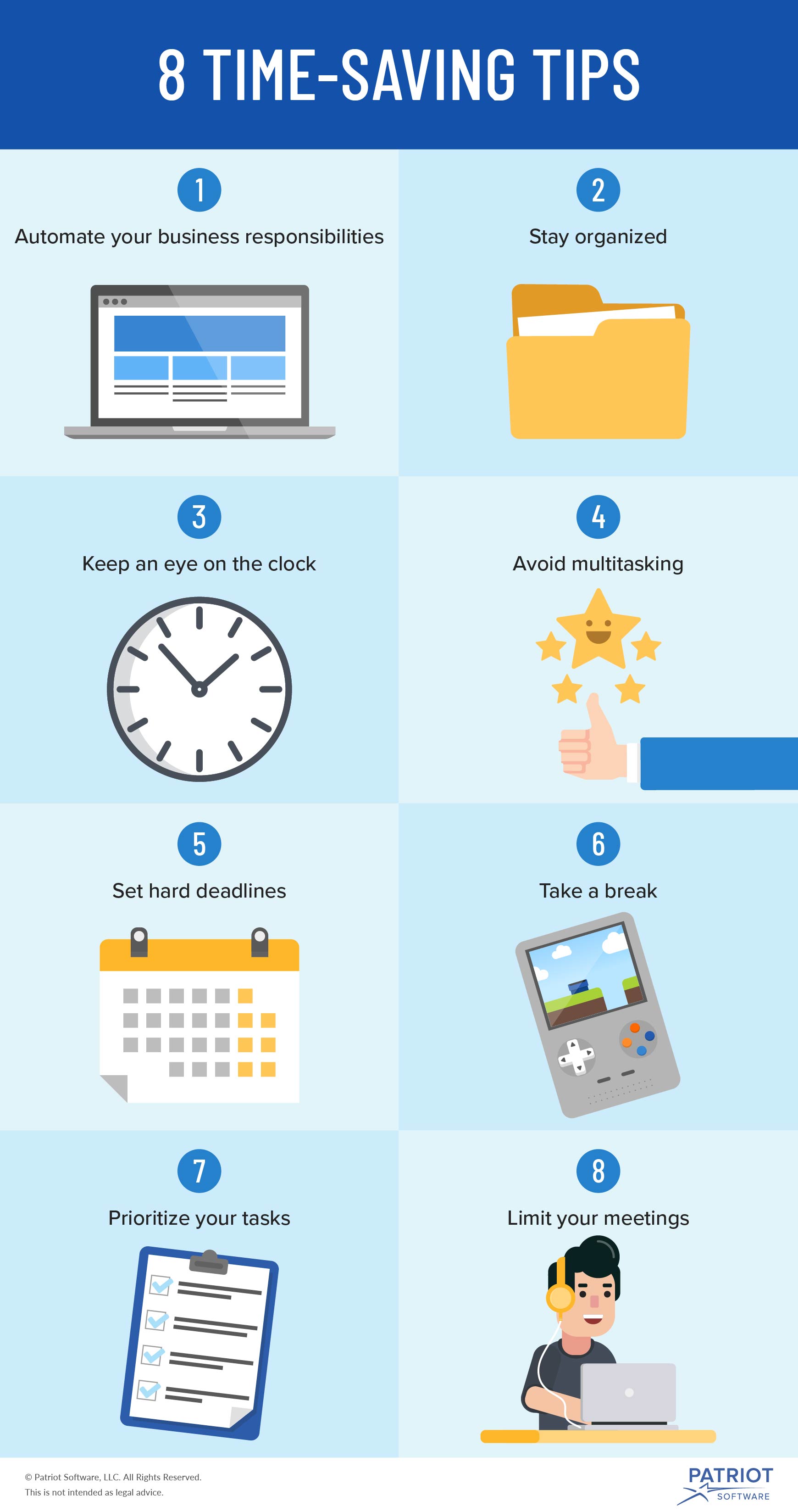No matter how driven, focused, or hard-working you are, it’s easy to lose track of time during a hectic workday. In the blink of an eye, your day or week is over. Small business owners know this feeling all too well. To be productive and use your time wisely, tweak your routine and utilize time-saving tips.
8 Time-saving tips
Use these eight time-saving techniques to streamline your business processes and increase productivity.

1. Automate your business responsibilities
To begin saving time in your day-to-day business operations, you can’t be afraid to automate. You can automate things like payroll, accounting, social media, and marketing to help save time.
Implementing automation tools allows you to simplify repetitive tasks and gives you more time to work on important projects. And, automated processes can help make sure your business runs like clockwork.
Consider automating your accounting and payroll duties by investing in accounting software and payroll software. There is even software built specifically for small business owners in mind, so you don’t have to break the bank to automate these processes.
Using automated email marketing tools allows you to send emails to all your customers or vendors without wasting time writing and sending emails to each individual.
Tools like Buffer and HubSpot allow you to schedule social media content. That way, you don’t have to worry about posting or forgetting to post to your accounts.
2. Stay organized
Organization is absolutely key for small business owners. Without it, you can get caught up searching for documents and files to complete your other responsibilities. The sooner you start to get organized, the more time you can save.
Create a filing system to remain organized at your workplace. Store documents by type and sort them in chronological order. Invest in supplies like labels, folders, and filing cabinets to maintain tip-top records.
Learn how to organize business receipts, payroll records, employee information, and other critical company records.
Along with organizing business information, you should also track daily work activities and projects. To organize your work days, use a calendar. Calendars can organize your meeting times, deadlines, and tasks.
3. Keep an eye on the clock
As a business owner, it’s easy to let the day get away from you. As soon as you know it, it’s 5 o’clock. Then all of a sudden, it’s Friday. To help reduce wasted time, keep an eye on the clock.
During the work day, pay attention to the time when you’re completing tasks. Figure out how much time you need to finish each task. Then, set miniature goals for yourself throughout the day to complete a project by a certain time.
Understanding how much time you need for each project can help you better plan your days and waste less time.
4. Avoid multitasking
According to one source, only 2% of people can effectively multitask. Chances are, you probably fall into the other 98%. Instead of handling multiple projects at once, stick to one task at a time.
Multitasking can decrease productivity and increase errors. I don’t know about you, but that sounds like a recipe for disaster. If you have a significant task, focus all of your attention and effort on it. Don’t get sidetracked trying to complete smaller tasks.
Also, consider breaking your larger tasks into milestones so you can work on them in stages. Doing so increases your chance of completing the task sooner and decreases the possibility of mistakes.
5. Set hard deadlines
You are likely used to assigning due dates for employees to get assignments done. But, do you do the same for yourself? Switch things up by setting your own hard deadlines.
Setting deadlines may be difficult at first. However, establishing due dates can reduce time spent on projects and save time for other tasks.
Consider setting hard deadlines for your projects, especially your bigger tasks. Deadlines can help motivate you to complete your work and give you the incentive to focus. Also, telling others about your deadlines can help hold you accountable.
6. Take a break
One study found that 90% of employees who take regular lunch breaks are more productive. To boost productivity, chisel out time for some much-needed breaks.
You might be wondering, How would taking breaks save me time? Because breaks make you more productive, you are more likely to finish projects sooner and save time to complete other projects.
As a business owner, you may find it challenging to step away from your desk. What if someone needs you? How will you get all your projects done? Instead of making excuses, devote time during the day for breaks.
Start off by taking mini-breaks (e.g., five minutes long) and work your way up to longer break periods. Consider also scheduling your breaks at specific times to designate when you should spend time away from work.
7. Prioritize your tasks
When you feel behind at work, you may need to put other tasks on the back burner. Instead of delaying or canceling projects time and time again, prioritize them.
Make a list of all your projects for the week and prioritize them from most to least important. Assess which tasks bring your business the most benefits and focus on them first.
Sometimes a shift in priorities causes you to push back a task. If you need to rearrange priorities as you go, that’s OK. Prioritizing tasks allows you to remain organized and motivated. And, it lets you accomplish tasks sooner so you can save time for other responsibilities.
If you find you can’t keep up with your list, consider doling out tasks to other workers. Look at your task list to see what others can handle. Assigning trusted employees additional responsibilities lets them gain experience and learn new skills. And, it helps lift a weight off your shoulders by decreasing your workload.
8. Limit your meetings
Meetings can be essential to growing your small business. But, they can also be a huge time waster.
Meetings that last too long, happen too frequently, or aren’t productive can hurt your business and waste time. Before scheduling meetings, determine whether or not the meeting is necessary.
Only accept and schedule mandatory meetings. Think about whether you can sum up something in an email or memo versus hosting a meeting.
If you do have a meeting, plan out what you want to accomplish beforehand. That way, you and your team can focus on goals and get done sooner. And instead of sitting in a meeting room, consider hosting virtual meetings via video chat or online to cut back on time.
Benefits of time-saving solutions
It’s no secret that saving time has many benefits for small businesses. And, some time-saving efforts have more advantages than others. Using the time-saving tips from above might allow you to:
- Increase productivity
- Reduce stress
- Become more organized
- Improve performance and quality
- Complete tasks more quickly
- Accomplish more tasks
